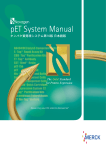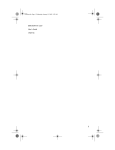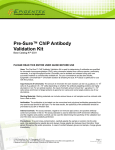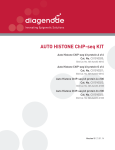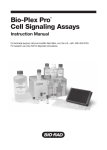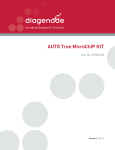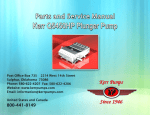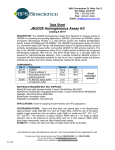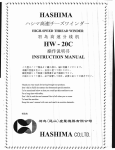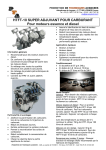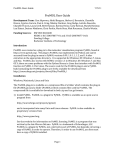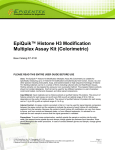Download Magna ChIP™ HT96
Transcript
TM Magna ChIP™ HT96 (Cat. No. 17-10077) EZ-Magna ChIP™ HT96 (Cat. No. 17-10078) High Throughput Chromatin Immunoprecipitation Kit FOR RESEARCH USE ONLY Not for use in diagnostic procedures USA & Canada Phone: +1(800) 645-5476 In Europe, please contact Customer Service: France: 0825.045.645; Spain: 901.516.645 Option 1 Germany: 01805.045.645 Italy: 848.845.645 United Kingdom: 0870.900.46.45 For other locations across the world please visit www.millipore.com/offices Introduction Chromatin in eukaryotic cells is associated with a plethora of structural, enzymatic, and regulatory proteins, which may interact with regional DNA sequences and affect genomic functions. This dynamic and coordinated interaction may influence the expression and cellular utilization of each gene locus, whether coding or non-coding. Thus, it is crucial to elucidate DNA-protein interactions in order to decipher the nuclear mechanisms underlying a wide variety of biological processes and disease states. ChIP (chromatin immunoprecipitation) is a powerful technique classically used for mapping the in vivo distribution of proteins associated with chromosomal DNA. These proteins can be histone subunits, transcription factors, or other regulatory or structural proteins bound either directly or indirectly to DNA. Successful ChIP requires high quality ChIP-validated antibodies that can specifically detect proteins associated with regions of chromosomal DNA. Traditionally, endpoint and quantitative PCR (qPCR) is performed after ChIP to verify whether a particular DNA sequence (the gene or region of the genome) is associated with the protein of interest. Using this classical approach, researchers can evaluate the interactions of the proteins of interest with a limited number of known target genes. Recently, the need has grown to map, characterize, and understand protein-DNA interactions across the epigenome. This can be done for multiple marks at a given locus as well as across the genome. The need to profile these interactions across the genome has led to the development of genome-wide ChIP analyses with either microarrays (ChIP-chip)† or next-generation sequencing (ChIP-seq)††. Genome-wide mapping of protein-DNA interactions and epigenetic marks helps to elucidate mechanisms of transcriptional control, and maintenance of chromatic and genomic DNA integrity within a cell. In certain cases the profile of this epigenome can be used to assess progression through differentiation; distinguish between normal and disease states; or predict responses to chemoprevention. For many laboratories, ChIP can be technically demanding, as it requires robust antibodies, high quality reagents, and careful planning and handling. The Magna ChIP™ HT96 kit was designed to address the technical challenges when processing a larger number of samples. The protocol and reagents provided simplify the standard ChIP procedure, improve the reproducibility and robustness of the ChIP process, and minimize the “hands-on” steps in ChIP. This kit allows ChIP to be done in a 96 well plate format. Researchers using this approach can perform up to 96 ChIP assays at once. Processing of samples can be performed using a multichannel pipette, or automated at multiple steps using standard liquid handlers. † For details on genome-wide analysis using microarrays please refer to the Magna ChIP2™ Microarray kit user manual (Cat. No. 17-1000, 17-1001, or 17-1002). †† For details on genome-wide analysis using ChIP-seq please refer to the Magna ChIP-Seq™ Chromatin Immunoprecipitation and Next Generation Sequencing Library Preparation Kit user manual (Cat. No. 17-1010). 1 Kit Overview The Magna ChIP HT96 kit provides a complete set of validated, quality controlled reagents, and a detailed protocol, with in-process quality control guidelines. Similar to the Magna ChIP HT96 kit, the EZ-Magna ChIP HT96 kit contains all of the materials required for high throughput ChIP plus positive and negative control antibodies and PCR primers that can be used as in-process controls, or for verification of technique. The materials provided in either kit allow the performance of up to 96 ChIP assays with as little as 10,000 cell equivalents of chromatin when exploring abundant epitopes, and as little as 100,000 cell equivalents when measuring less abundant proteins such as sequencespecific transcription factors. Although these kits are designed for performing 96 ChIP assays in a single experiment, it is possible to conduct fewer reactions. If fewer reactions are used, additional 96-well plates for sample processing (not provided) are required. The Magna ChIP HT96 kits utilize a magnetic protein A/G bead blend that provides multiple advantages over single-bead approaches. In contrast to kits with either protein A or protein G, our Magna ChIP A/G beads allow use of a wider variety of antibody isotypes. In addition, the magnetic properties of these beads permit rapid processing of ChIP reactions with the use of a multichannel pipette and magnetic separation stand such as the Magna GrIP™ HT96 Rack (Cat. No. 17-10071) or with the use of an automated liquid handler. The Magna ChIP HT96 protocol has been designed and optimized for efficient immunoprecipitation and recovery of DNA. Consequently, in many cases, a specific DNA purification product is not required for downstream qPCR. This is especially true when using the Magna ChIP HT96 kit with high quality antibodies to abundant epitopes such as histone modifications and nuclear enzymes. However, for low abundance targets, researchers may consider the use of DNA purification products such as the Agencourt® AMPure® XP DNA Clean beads or other small-volume elution DNA purification products to concentrate the final DNA product prior to qPCR detection. An optional protocol for using the Agencourt beads (not supplied) in combination with the Magna ChIP HT96 kit is provided. For your specific genomic region of interest, a ChIP-validated antibody demonstrated to enrich for your target region is required. Millipore offers a wide selection of highly specific antibodies demonstrated to work in ChIP (ChIP-qualified antibodies) as well as a collection of rigorously validated antibodies and control primer sets known as ChIPAb+™ kits (see page 6 or visit www.millipore.com/epigenetics to search a complete list of targets). 2 Kit Components The Magna ChIP HT96 kit provides sufficient reagents for 24 individual chromatin preparation reactions and 96 chromatin immunoprecipitation reactions. The EZ-Magna ChIP HT96 kit includes these reagents plus positive and negative control antibodies and a human genome specific primer set for qPCR analysis. For primers that can be used for non-human cell lines or tissues, visit www.millipore.com. Magna ChIP™ HT96 High Throughput Chromatin Immunoprecipitation Kit Contents Kit Configurations Magna ChIP™ HT96 EZ-Magna ChIP™ HT96 (Cat. No. 17-10077) (Cat. No. 17-10078) MAGNA0022 (2°C to 8°C) MAGNA0022 (2°C to 8°C) MAGNA0023 (-20°C) MAGNA0024 (-20°C) MAGNA0022 (2° to 8°) Component Catalog # HT96 Nuclei Isolation Buffer CS207317 10X Glycine CS207294 10X PBS CS207282 HT96 ChIP Buffer (Sonication/ChIP/Wash) CS207283 Magna ChIP Protein A/G Magnetic Beads CS207285 HT96 Low Stringency IP Wash Buffer CS207284 HT96 ChIP Elution Buffer CS207288 Store the Following at Room Temperature Upon Receipt 96 well ChIP Plate CS209289 96 well Thermal Plate CS207290 Plate seal Strip caps MAGNA0023 (-20°C) Store at -20°C Upon Receipt Component Catalog # Protease Inhibitor Cocktail III, Animal Free 535140-1ML **Contains DMSO Proteinase K Solution, 600mAU/mL CS207286 MAGNA0024 (-20°C) Store at -20°C Upon Receipt Component Catalog # Protease Inhibitor Cocktail III, Animal Free 535140-1ML **Contains DMSO Proteinase K Solution, 600 mAU/mL CS207286 Anti-Trimethyl-Histone H3 (Lys4) CS200580 Normal Rabbit IgG CS200581 GAPDH primers 22-004 Quantity 15 mL 60 mL 60 mL 80 mL 1.1 mL 30 mL 20 mL 2 1 3 12 Quantity 1.0 mL 0.2 mL Quantity 1.0 mL 0.2 mL 75 µL 75 µL 75 µL Functional Validation: Magna ChIP HT96 modules are functionally tested in quantitative ChIP reactions to ensure quality control of the supplied components. 3 Materials Required But Not Supplied Reagents • • Cells, stimulated or treated as desired Antibody of interest for chromatin immunoprecipitation (see page 6 ) • • 37% Formaldehyde Taq DNA polymerase (e.g. NovaTaq™ Hot Start DNA Polymerase Cat. No. 71091) dNTPs, 2.5 mM each (e.g. Novagen® 10 mM dNTP Mix, Cat. No. 71004) SYBR® Green Master Mix for qPCR or stock of SYBR Green for blending into qPCR reaction • • • DNase- and RNase-free sterile H2O • 2% Agarose gel • 50 bp DNA Ladder (e.g. NEB Cat. No. N3236S) • • 6X gel Loading buffer DNase- and RNase-free sterile H2O (e.g. Millipore Nuclease-free water Cat. No. 3098) Equipment • Microscope and cell counter • Magnetic Separator for microcentrifuge tubes (Magna GrIP™ Rack (8 Well), Cat. No. 20-400) • Magnetic Separator for 96 well plate (Magna GrIP™ HT96 Rack, Cat. No. 17-10071) • Vortex mixer • Rotating end-over-end wheel/platform (e.g. Labnet Mini LabRoller™ rotator) • Microcentrifuge • Sonicator • Thermomixer and adapter for 96 well plate • Variable temperature water bath or incubator • Timer • Variable volume (5-1000 µL) pipettors + tips • Cell scraper • Microcentrifuge tubes, 1.5 mL • Thermal cycler • Real-time PCR Instrument • Filter-tip pipette tips Hazards o Wear gloves when using this product. Avoid skin contact or ingestion of all reagents and chemicals used in this protocol. o Protease Inhibitor Cocktail III contains DMSO, avoid contact with skin. o Chromatin preparation may require use of liquid nitrogen. Use personal protective equipment (PPE) when handling liquid N2 to avoid burns. o Use PPE, fume hoods and venting when working with concentrated formaldehyde solutions. Formaldehyde is toxic by inhalation, skin contact and ingestion. Storage and Stability MAGNA0022: Store at 2°C-8ºC; good for 6 months from date of re ceipt when reagents are stored properly. Please note: Some components provided in this kit should be stored at room temperature (18-25ºC) upon receipt. Please see “Kit Components” section for specific components. MAGNA0023 and MAGNA0024: Store at -20ºC; good for 6 months from date of receipt when reagents are stored properly. 4 ChIPAb+™ Validated Antibodies and ChIP Qualified Antibodies For the ChIP application, not all antibodies are capable of effectively precipitating chromatin. Protein conformation, protein interactions (with other proteins or DNA), and the amount of crosslinking can affect whether or not an antibody will work well in ChIP. Consequently, we make a distinction between what we call "ChIP qualified" antibodies, and "ChIP validated" antibodies. ChIP qualified, or ChIP grade is a term typically used to describe any antibody previously demonstrated to work in ChIP. Although not always directly tested by the supplier, many consider these to be ‘validated’ for ChIP. For some, this level of validation is sufficient. However, antibody performance in ChIP can vary between different lots. Consequently, in many cases antibodies labeled as ChIP grade fail to perform consistently from lot to lot. To eliminate this concern, when performing ChIP it is suggested that labs use well characterized antibodies that have been extensively evaluated for specificity, proven to perform in ChIP, and lot validated using ChIP. An example of these types of antibodies is the ChIPAb+ Validated Antibody and Primer Sets. ChIPAb+ antibodies are rigorously validated to ensure specificity and their ability to immunoprecipitate chromatin. In addition, each and every lot of a ChIPAb+ antibody is subject to extensive quality control testing including testing in the ChIP application. ChIPAb+ antibodies are more than just a highly validated antibody. To allow independent verification of performance or for use as a positive control, all ChIPAb+ antibodies include a negative control IgG plus PCR primers directed against a known positive locus. A partial list of ChIPAb+ antibodies is given in the table below. Catalog Number 17-622 17-614 17-658 17-625 17-648 17-601 17-662 17-615 17-663 17-678 17-677 17-10051 17-10050 17-641 17-672 17-608 17-10032 17-661 17-10046 Catalog Number 17-10044 17-681 17-630 17-613 17-603 17-643 17-10048 17-10054 17-10057 17-10045 17-10098 17-10131 17-675 17-10130 17-600 17-656 17-10034 17-685 17-620 Description ChIPAb+ Trimethyl-Histone H3 (Lys27) ChIPAb+ Trimethyl-Histone H3 (Lys4) ChIPAb+ Acetyl-Histone H3 (Lys9) ChIPAb+ Trimethyl-Histone H3 (Lys9) ChIPAb+ Dimethyl-Histone H3 (Lys9) ChIPAb+ Sp1 ChIPAb+ EZH2, clone AC22 ChIPAb+ Acetyl Histone H3 ChIPAb+ EED ChIPAb+ Trimethyl-Histone H3 (Lys4) ChIPAb+ Dimethyl-Histone H3 (Lys4) ChIPAb+ Acetyl-Histone H3 (Lys14) ChIPAb+ Acetyl-Histone H3 (Lys4) ChIPAb+ REST ChIPAb+ RNA Pol II ChIPAb+ HDAC1 ChIPAb+ Trimethyl-Histone H3 (Lys36) ChIPAb+ SUZ12 ChIPAb+ Histone H3 (C-term) Description ChIPAb+ CTCF ChIPAb+ Dimethyl-Histone H3 (Lys9) ChIPAb+ Acetyl Histone H4 ChIPAb+ p53 ChIPAb+ ER ChIPAb+ Monomethyl Histone H3 (Lys27) ChIPAb+ Histone H2A.Z ChIPAb+ Histone H2B ChIPAb+ SMRT ChIPAb+ Acetyl-Histone H4 (Lys5) ChIPAb+ TATA Binding Protein (TBP) ChIPAb+ Phospho-CREB (Ser133) ChIPAb+ Histone H3 (Unmod Lys4) ChIPAb+ Trimethyl-Histone H3 (Lys79) ChIPAb+ CREB ChIPAb+ Sox-2, clone 6F1.2 ChIPAb+ EED (Rabbit Poly) ChIPAb+ Phospho-Histone H3 (Ser10) ChIPAb+ RNA Polymerase II For a complete listing of Millipore’s ChIPAb+ validated antibody/primer sets, visit www.millipore.com/epigenetics and search ChIPAb+ To see all available antibodies visit www.millipore.com/antibodies 5 Getting the Best Possible Results Using the Magna ChIP™ HT96 Kit The Magna ChIP HT96 protocol used in this manual is a modified version of the protocol used in our existing Magna ChIP kits. This high throughput ChIP protocol was designed for efficient ChIP using lower amounts of input chromatin and antibody. In addition, the streamlined wash simplifies the procedure and generates more consistent ChIP results when processing a large number of samples. Similar to the Magna ChIP Chromatin Immunoprecipitation kits (Cat. No. 17-610, 17-611, 17-408, 17409, 17-10085, and 17-10086), it is possible to perform the ChIP portion of this protocol in a single day using a shortened protocol that reduces incubation time. However, for some antibodies this shorter protocol can result in slightly reduced ChIP efficiency. Regardless of your approach, to ensure the best possible results, advance planning is advised. It is strongly recommended that you read the entire protocol before performing this procedure, especially if you are using this kit for the first time. A general overview of the major steps of a typical Magna ChIP HT96 workflow is provided on page 9. The detailed protocols and guidelines presented here will help you to avoid common pitfalls. It is critical to review and follow the suggestions in the “Experimental Considerations” section. It is also important to take the time to evaluate the samples being prepared after key steps in the protocol. This will save time and materials, and minimize the potential for sub-optimal results. Important Information for Processing Partial Plates The Magna ChIP HT96 kit provides sufficient reagents to run fewer than 96 reactions in three separate experiments. To run these partial plates, it is strongly recommended that new 96-well ChIP and 96-well Thermal plates with new plate seals or caps are used (see below for ordering information). New plates minimize the risk of cross contamination of samples and confounding data in sensitive endpoint analyses, such as qPCR. Ordering Information: Additional 96-well plates for running partial plates Description Catalog # Magna ChIP™ HT96 ChIP and Thermal Plate Set 17-10457 Magna ChIP™ HT96 Thermal Plate Set 17-10458 Magna ChIP™ HT96 ChIP Plate Set 17-10459 6 Components 96-well ChIP plates (2) 96-well Thermal plate (1) Plate seals (3) Strip caps (12) 96-well Thermal Plate (1) Strip caps (12) 96-well ChIP plates (2) Plate seals (3) Chromatin Immunoprecipitation: Experimental Considerations ChIP-validated antibodies are perhaps the most important component of a ChIP experiment. Ensure that the antibody being used has been validated in ChIP using genomic locations of both predicted high and low occupancy. Secondly, ensure that the quality of the chromatin being prepared is suitable in functional ChIP assays, using control antibodies where possible, and by testing a range of fragmentation by agarose gel electrophoresis. If you wish to check your technique or have a source of controls, you can utilize the validated positive and negative control antibodies and qPCR assay provided in the EZ-ChIP kit or consider using a ChIPAb+ validated antibody (see page 6) and qPCR primer set. Chromatin size is critical to the success of ChIP. This protocol works best when the chromatin size is between 200-1000 bp. Shearing of chromatin varies greatly, depending on cell type, growth conditions, quantity, volume, crosslinking, and equipment. It may be necessary to optimize sonication conditions by changing the power settings, cycle number and ratios of time ON and time OFF. The quality of the chromatin should be evaluated by agarose gel electrophoresis of Proteinase K-digested, crosslink-reversed purified DNA fragments. Cell number equivalents of chromatin required per ChIP reaction is dependent on the quantity of available epitopes in the cell of interest as well as the quality of antibody used. Successful enrichment can be performed with as low as 1X104 cells per ChIP when utilizing high quality antibodies directed towards abundant epitopes such as several histone modifications and RNA Polymerase II. It is recommended to increase the amount of cells when the antibody is less optimal or the number of epitopes per cell is lower. The Magna ChIP HT96 approach used in this manual recommends preparing chromatin in batch format; for approximately 10 ChIP samples per preparation with 1,000,000 cultured cells; or for approximately 10 ChIP samples per preparation with 50 mg of tissue samples. Sufficient buffers for chromatin preparation are provided to enable chromatin preparation for up to 24 samples. Thus, 240 reactions can be generated depending upon cell number (e.g. 100,000 cells/ChIP) but 96 independent chromatin preps are not possible with the reagents as provided. qPCR is typically used to evaluate the success of ChIP. A mock IgG or negative antibody control ChIP reaction may be performed to determine fold enrichment relative to a specific ChIP antibody. Alternatively, a negative locus control may also be used for normalization to minimize chromatin and ChIP reagent requirements. If you are inexperienced in the methodology of ChIP, or unsure of the performance of your antibody in ChIP, you may consider conducting a classical ChIP experiment using a kit such as the EZ-Magna ChIP™ kit (Cat. No. 17-10085). 7 Overview of Magna ChIP™ HT96 Workflow 8 Detailed Protocol Chromatin Immunoprecipitation–Please Read Entire Protocol First A. In Vivo Crosslinking of Proteins to DNA I. Cultured cells 1. If necessary, stimulate or treat adherent mammalian cells at ~80 to 90% confluence in a 150 mm culture dish containing 20 mL of growth media. Include one extra plate of cells to be used solely for estimation of cell number. 7 For HeLa cells, this is approximately 1 x 10 cells. This will generate a preparation of chromatin 5 sufficient for 100 separate immunoprecipitations when using 1 X 10 cell equivalents/reaction. Use the same amount of buffer when making chromatin from fewer cells. The volume of buffers supplied in the kit is sufficient to generate chromatin from up to 24 150 mm plates of cultured cells, each plate providing chromatin for up to 1000 chromatin immunoprecipitations (varies with cell and assay type). Chromatin from other types of culture vessels can be isolated with slight modifications to the protocol. Cell numbers can be scaled according to the performance of the antibody of interest to optimize highest signal-to-noise ratio relative to negative control (mock IgG or negative-location control). For 4 example, Magna ChIP™ HT96 control antibodies can perform successful ChIP of as few as 1 X 10 5 HeLa cells. This protocol is written for simplicity using 1 X 10 cells per ChIP to ensure optimal performance of the control antibodies. 2. Prepare 22 mL of 1X PBS (2.2 mL 10X PBS and 19.8 mL water) for each 150 mm culture dish. Store on ice. This will be used for washes and needs to be ice cold. 3. Thaw the 200X Protease Inhibitor Cocktail III at room temperature for later use. This product contains DMSO and will remain frozen below 18.4°C. 4. Add 540 µL of 37% formaldehyde (or 1100 µL of 18.5% formaldehyde) directly to 20 mL of growth media to crosslink. Gently swirl dish to mix. 5. Final concentration of formaldehyde is 1%. Use high quality (molecular-biology grade) formaldehyde. Formaldehyde is stabilized with methanol. Upon evaporation of methanol, formaldehyde might form a white precipitate. Do not use if white precipitate is visible in the solution. Incubate at room temperature for 10 minutes. Agitation of cells is not necessary. Performing crosslinking in low serum conditions with culture media or PBS is optional, as an optimization parameter to improve crosslinking efficiency. Crosslinking time can be increased but may result in higher non-specific association of DNAs with the ChIP antibody of interest. 6. During the ten minute incubation, prepare 1X protease inhibitor in PBS: Add 2 mL of ice cold 1X PBS to a separate tube for every dish and add 10 µL of the 200X Protease Inhibitor Cocktail III. Store on ice. 7. Add 2 mL of 10X glycine to each dish to quench excess formaldehyde. 8. Swirl to mix and incubate at room temperature for 5 minutes. 9. Place dishes on ice. 10. Aspirate medium, removing as much medium as possible, being careful not to disturb cells. If you are using suspension cells, spin down cells at 8000 x g for 5 minutes. 11. Add 10 mL of cold 1X PBS to wash cells. Remove 1X PBS. 9 the 12. Remove 1X PBS and repeat wash. 13. Add 2 mL of 1X Protease Inhibitor Cocktail III in PBS prepared in Step 6. 14. Scrape cells from each dish into a separate microcentrifuge tube. 15. Spin at 800 x g at 4°C for 5 minutes to pellet cells. II. Fresh tissue 1. Isolate non-fixed fresh tissue as desired. Use a razor blade to cut a pea-size piece of tissue into small pieces (typically 1 mm or smaller) to improve crosslink efficiency. Alternatively, a plug of tissue from cryosectioned non-formalin-fixed-paraffin-embedded (FFPE) material can be used to obtain a small sample of interest (please see the Magna ChIP™ G Tissue Kit manual, Cat. No. 17-20000). 7 A pea-size mass of tissue contains around 10 cells and should be sufficient for 100 ChIP samples. Specimens should be handled carefully and promptly to preserve specimen integrity. 2. Weigh the tissue, and then transfer into a 50 mL tube and wash twice with ice cold 1X PBS. 3. Resuspend tissue in 20 mL ice cold PBS and add 540 µL of 37% formaldehyde (or 1100 µL of 18.5% formaldehyde) to crosslink. Gently swirl dish to mix. 4. Incubate at room temperature for 10 minutes. 5. In the interim, prepare 1X protease inhibitor in PBS: Add 2 mL of ice-cold 1X PBS to a separate tube for every sample and add 10 µL of Protease Inhibitor Cocktail III. Store on ice. 6. Add 2 mL of 10X glycine to quench excess formaldehyde. 7. Homogenize the tissues several times using a Dounce homogenizer (loose pestle). 8. Spin at 800 x g at 4°C for 5 minutes to pellet cells. B. Cell Lysis to Release Cross-Linked Proteins/DNA 1. In the interim, prepare 0.5 mL of HT96 Nuclei Isolation Buffer containing 2.5 µL of 200X Protease Inhibitor Cocktail III for each microcentrifuge tube. 2. Remove supernatant. (Cell pellet can be frozen at -80°C at this step.) 3. Resuspend cell pellet in HT96 Nuclei Isolation Buffer (prepared in Step 1). 4. Incubate on ice for 15 minutes: vortex the cell suspension briefly every 5 minutes. 5. (Optional) At the end of the incubation, homogenize the cell suspension 10 times in a Dounce homogenizer to facilitate the release of the nuclei. 6. Spin the cell suspension at 800 x g at 4°C for 5 minutes. 7. In the interim, prepare 0.5 mL of HT96 ChIP Buffer containing 2.5 µL of 200X Protease Inhibitor Cocktail III for each microcentrifuge tube (as before, Step 1). 8. Remove supernatant. Resuspend cell pellets in HT96 ChIP Buffer (from Step 7). 9. 7 For every 1 x 10 HeLa cells, 0.5 mL of HT96 ChIP Buffer is recommended when using this protocol. 7 It is recommended that cell concentration is less than 2 x 10 cells/mL, as the ratio of lysis buffer to cell density is important for reliable cell lysis. If optimal conditions for sonication have already been determined, proceed to Section C. Otherwise, see Appendix A. 10 C. Sonication of Isolated Chromatin to Shear DNA Important: Optimal conditions need to be determined to shear crosslinked DNA to ~200-1000 base pairs in length. See Appendix A for a typical optimization protocol. Once shearing conditions have been optimized, proceed with the steps below. 1. If desired, remove 5 µL of cell lysate from Section B, Step 7, for agarose gel analysis of unsheared DNA. 2. Sonicate cell lysate on wet ice (ice-water mixture). The efficiency of sonication depends upon cell type, cell equivalents and instrumentation. When possible, consult your instrument manufacturer’s guidelines for instrument operation. An example of sonicated HeLa cell chromatin fractionated suitably for use with Magna ChIP™ HT96 is shown in Figure 1. Keep cell lysate ice cold. Sonication produces heat, which can denature the chromatin. Allow at least 30 seconds between cycles of sonication to prevent sample overheating. 3. Spin at a minimum of 10,000 x g, but not exceeding 15,000 x g, at 4°C for 10 minutes remove insoluble material. 4. Prepare a 5 µL aliquot for agarose gel analysis of the sheared DNA according to the protocol in Appendix A , Steps VII to X. Store on ice if gel analysis will be done in the same day; otherwise store aliquot at - 20ºC. to It is important to do this step to ensure chromatin is sheared to appropriate size. 5. Remove supernatant and place 50 µl aliquots into new microcentrifuge tubes. 6. Each 50 µL aliquot contains 1 x 106 cell equivalents of lysate which is enough for up to immunoprecipitations. 7. Sheared crosslinked chromatin can be stored at -80°C for up to 3 months. 10 D. Immunoprecipitation (IP) of Crosslinked Protein/DNA Prior to starting this section: • Remove 200X Protease Inhibitor Cocktail III and thaw at room temperature. This product contains DMSO and will remain frozen below 18.4°C. • Always add protease inhibitors to all buffers before use unless directed otherwise. All buffers should be chilled on ice before use. • If using an automated workstation, see Section D-II. • To run partial plates, it is strongly recommended that new plates be used to minimize potential cross contamination of samples. Additional 96-well ChIP plates, 96-well Thermal plates, plate seals, and strip caps are available; please see page 6 for further details and ordering information. I. Chromatin immunoprecipitation using a multichannel pipettor 1. Gently shake the Magna ChIP A/G Magnetic Beads tube to resuspend any magnetic particles that may have settled. Dispense the appropriate volume of Magna ChIP A/G Magnetic Beads (10 µL per ChIP reaction) to a microcentrifuge tube then place the tube on a magnetic separator for 1 minute. If a microcentrifuge magnetic rack is not available, a single pin of the Magna GrIP rack (96 well) can be used for this purpose. 11 2. Remove supernatant. Add 5 beads volume of HT96 ChIP buffer (5 times the volume of bead used) then remove tube from the magnetic separator and mix the beads by gently pipette-mixing several times to completely resuspend beads. Place the tube on the magnetic separator for 1 minute. 3. Repeat Step 2 and remove supernatant. 4. Resuspend beads in one bead volume of HT96 ChIP buffer. 5. In the 96 well ChIP Plate, add ~90 µL HT96 ChIP buffer (see note below), 10 µL beads, and the appropriate quantity of antibody per well. Final volume should be 100 µL; For 96 reactions, this would be 960 µL. 6. The amount of antibody used per ChIP must be empirically determined. In general, 1-10 µg of purified antibodies is generally sufficient for standard immunoprecipitations. For Magna ChIP™ HT96, 3 µL of the Anti-Trimethyl-Histone H3 (Lys4) control antibody (CS207358) is sufficient for 100,000 cells and as little as 1 µL can be used for fewer cells. The amount of antibody used per reaction may require optimization, and in general, lower amounts of antibody are appropriate for Magna ChIP™ HT96 reactions. It is recommended to perform a negative control ChIP using normal IgG or no antibody. It is also a good idea to include technical replicates in your experiment. Cover and gently shake the plate to resuspend magnetic particles then place the plate on an end-over-end rotator at 50-100 rpm for two hours at 4°C, to keep beads from settling out of solution. 7. For multipipette application, a trough may be used for distribution of 10 µL bead volumes. Include sufficient overage to enable multichannel pipetting. Ensure that the top of the plate is dry before applying the plastic seal; seal tightly. Ensure end-overend rotation in mixing. During the incubation, dilute the sonicated chromatin with the HT96 ChIP buffer to the cell concentration you wish to test. For example, if you are performing 10 ChIP reactions, each with 100, 000 cells, then add 1, 000, 000 cell equivalent of chromatin to 1 mL of ChIP buffer, then add 100 µL of diluted chromatin to each well. (You may need to prepare extra if you are using a multichannel pipette and reservoir.) Save 5 µL of dilute chromatin in a microcentrifuge tube and store at -20°C; this will be used as 5% input t he following day (Step 17). In order to get a useful standard curve during qPCR analysis, the input should contain chromatin that is equivalent of 50,000 or more cells. Otherwise use 5 µL of undiluted chromatin and adjust the percentage accordingly. 8. Spin down the plate briefly; place the plate on the magnetic separator for 1 minute. 9. Remove supernatant, then add 100 µL dilute chromatin to each well. 10. Cover and gently shake the plate to resuspend magnetic particles and place the plate rotating platform at 50-100 rpm overnight at 4°C. on a Ensure that the top of the plate is dry before applying the plastic seal; seal tightly. 11. Spin down the plate at 800 x g for 1 minute then place the plate on the magnetic separator for 1 minute. 12. Remove supernatant, being careful not to disturb the beads. 13. Add 100 µL cold HT96 ChIP buffer; remove the plate from the magnetic separator and the beads by gently pipetting several times. Place the plate on the magnetic separator minute then remove the supernatant. 14. Repeat wash with cold HT96 ChIP buffer twice (as described in Step 13). 15. Wash with HT96 Low Stringency IP Wash Buffer (as before, Step 13). 12 mix for 1 16. Resuspend the beads in 100 µL HT96 Low Stringency Buffer then transfer to 96 well Thermal Plate. Place the 96 well Thermal Plate on the magnetic separator for 1 minute then remove the supernatant. 17. Resuspend beads in 50 µL HT96 ChIP Elution Buffer (without protein inhibitor cocktail) and add 1 µL Proteinase K. Add proteinase K to elution buffer to make a stock solution, and use a multichannel pipette to dispense the stock solution. 18. Add 45 µL HT96 ChIP Elution Buffer and 1 µL Proteinase K to input (see Step 7) 19. Cover the 96 well Thermal Plate with strip caps; incubate the plate and input in a Thermomixer at 65°C for 2 hours and then at 95°C for 15 minutes . Let the plate cool to room temperature. Please use the supplied strip caps in this step. The plastic plate seal does not seal properly during long periods of heating. 20. Place the 96 well Thermal Plate on the magnetic separator for 1 minute then transfer 45 µL of the supernatant to a new 96 well ChIP Plate; be careful not to transfer the beads. II. Automated Chromatin Immunoprecipitation The protocol below was done using the TECAN Freedom EVO® robotic workstation. This approach can be used as a guide to using other automated liquid handing systems for appropriate steps in chromatin immunoprecipitation. 1. Gently shake the Magna ChIP A/G Magnetic Beads tube to resuspend any magnetic particles that may have settled. Add the appropriate amount of Magna ChIP A/G Magnetic Beads (10 µL/ChIP) to a microcentrifuge tube, then place the tube on a magnetic separator for 1 minute. 2. Remove supernatant. Add one bead volume of HT96 ChIP buffer, remove tube from the magnetic separator and mix the beads by gently pipetting several times to completely resuspend the beads. Place the tube on the magnetic separator for 1 minute. 3. Repeat wash. 4. Remove supernatant and resuspend beads in one bead volume of HT96 ChIP buffer. 5. Dilute antibody with HT96 ChIP buffer so that the concentration for each antibody is appropriate for HT96 ChIP (20 ng/µL for most antibodies), and add 100 µL or more of antibody to a standard 96 well plate (not provided). The amount of antibody used per ChIP must be empirically determined. In general, 1-10 µg of purified antibodies is generally sufficient for standard immunoprecipitations. For Magna ChIP™ HT96, 3 µL of the Anti-Trimethyl-Histone H3 (Lys4) control antibody (CS207358) is sufficient for 100,000 cells and as little as 1 µL can be used for fewer cells. The amount of antibody used per reaction may require optimization, and in general, lower amounts of antibody are appropriate for Magna ChIP™ HT96 reactions. We recommend that you perform a negative control ChIP using normal IgG or no antibody. It is also a good idea to include replicates in your experiment 6. Add diluted beads to a reservoir. Place antibody plate, magnetic separator and beads in Freedom EVO® robotic workstation. Place ChIP plate on top of magnetic separator. 7. Transfer 50 µL diluted antibodies and 50 µL beads to the ChIP plate using TECAN. 8. Cover and gently shake the plate to resuspend magnetic particles and place the plate rotating platform at 50-100 rpm for two hours at 4°C. on 9. During the incubation, dilute the sonicated chromatin with the HT96 ChIP buffer to the concentration you wish to test. Save 5 µL of dilute chromatin in a microcentrifuge tube store at -20°C; this will be used as 5% input the f ollowing day (Step 20). cell and 13 a In order to get a useful standard curve during qPCR analysis, the input should contain chromatin that is equivalent of 50,000 or more cells. Otherwise use 5 µL of undiluted chromatin and adjust the percentage accordingly. 10. Add diluted chromatin to either a reservoir or a standard 96 well plate (not provided). Place chromatin in TECAN. 11. Spin down the 96 Well ChIP Plate briefly; place the plate on the magnetic separator for 1 minute. 12. Remove supernatant; add 100 µL dilute chromatin per well using TECAN. 13. Cover and gently shake the plate to resuspend magnetic particles and place the plate rotating platform at 50-100 rpm overnight at 4°C. on a 14. Add sufficient cold HT96 ChIP buffer and HT96 Low Stringency IP Wash Buffer in separate reservoirs and place in TECAN. 15. Spin down the 96 well ChIP Plate briefly; place the plate on the magnetic separator for 1 minute. Remove supernatant. 16. Add 100 µL cold HT96 ChIP buffer, incubate for 3 min then remove the supernatant. 17. Repeat wash with cold HT96 ChIP buffer twice (as described in Step 16). 18. Wash with HT96 Low Stringency IP Wash Buffer twice (as before, Step 16); during the second wash, transfer the beads mix to the 96 well Thermal Plate. Place the 96 well Thermal Plate on the magnetic separator for 1 minute and remove the supernatant. 19. Resuspend beads in 50 µL HT96 ChIP Elution Buffer and add 1 µL Proteinase K. It is useful to set up a mastermix so that Proteinase K is equal in each sample 20. Add 45 µL HT96 ChIP Elution Buffer and 1 µL Proteinase K to input (see Step 9). 21. Cover the 96 well Thermal Plate with strip caps, incubate the plate and input in a Thermomixer at 65°C for 2 hours then at 95°C for 15 minutes. Al low the plate to cool down to room temperature. Please use the supplied strip caps in the step. The plastic plate seal does not seal properly during long periods of heating. 22. Place the 96 well Thermal Plate on the magnetic separator for 1 minute and add 45 µL of the supernatant to a new 96 well ChIP Plate; be careful not to transfer the beads. E. DNA Purification (Optional) DNA purification is not required for qPCR analysis, but is required for some downstream applications such as ChIP-chip and ChIP-seq. DNA purification allows detection of lower concentration immunoprecipitates associated with some DNA binding proteins. We recommend Beckman Agencourt AMPure® XP DNA purification system (Cat. No. A63880) if DNA purification is required for your analysis. 1. Gently shake the Agencourt AMPure XP DNA purification beads bottle to resuspend any magnetic particles that may have settled. Add DNA purification beads according to the solution volume chart below. Volume (µL) 10 20 50 100 DNA purification beads Volume (µL) 18 36 90 180 14 2. Mix reagent and ChIP DNA thoroughly by pipette mixing 10 times in a standard 96 well plate (not supplied). Let the mixed samples incubate for 5 minutes at room temperature for maximum recovery. 3. Place the reaction plate onto a Magna GrIP™ Rack (96 well) for 2 minutes to separate beads from the solution. 4. Aspirate the cleared solution from the reaction plate and discard. 5. Keep the plate on the magnetic stand, dispense 200 µL of 70% ethanol to each well of the reaction plate, and incubate for 30 seconds at room temperature. Aspirate the ethanol and discard. Repeat for a total of two washes. 6. Off the magnet plate, add 40 µL of water to each well of the reaction plate and pipette- mix 10 times. 7. Place the reaction plate onto a Magna GrIP Rack (96 well) for 1 minute to separate beads from the solution. 8. Transfer the eluant to a new plate (not supplied). F. Real-Time Quantitative PCR to Verify Chip DNA Enrichment The success of ChIP can be evaluated through qPCR. Verification of ChIP enrichment can be performed using the relative standard curve method of qPCR analysis to compare DNA from a mock IP vs. DNA immunoprecipitated using your ChIP antibody, or can alternatively be compared using relative standard curve with two PCR amplicons, a positive control binding region, and a negative control location region. Input DNA is required whether using relative standard curve method or the comparative Ct (∆∆Ct) method. An example of good fold enrichment is shown in Figure 2. 1. Add 2 µL of the sample to a PCR plate suitable for your real time instrument of choice (not supplied). 2 µL or less ChIP DNA is recommended for a 20 µL PCR reaction. Performing triplicate of qPCR reactions per ChIP sample is also recommended. If using the relative standard curve method, perform 3-4 5 or 10 fold serial dilutions using the reverse crosslinked DNA from the 5% input sample, and use these samples to build a standard curve. Concentration of the ChIP samples can be calculated as percent of input using the standard curve. Alternatively, data can be calculated in relation to cell equivalents of chromatin, or mass of purified DNA, if desired. 2. Prepare a qPCR mastermix as shown in Table I. Prepare a sufficient volume of mastermix for one extra tube to account for pipette carryover. 3. Add 23 µL of qPCR mastermix to the 2 µL of the sample. 4. Use caps or an optical tape to seal the plate and start the qPCR reactions. Please refer to Figure 2 for real-time PCR result. Table I. qPCR reagent setup and running parameters qPCR reagent assembly for 1 reaction: ddH2O ® SYBR -Green Master Mix Primer mix Total 9.5 µl 12.5 µl 1 µl 23 µl qPCR parameters: Initial Denature 94°C 10 min Denature 94°C 20 sec 50 times Anneal and Extension: 60°C 1 min 15 G. Data Analysis There are many algorithms to analyze ChIP result; the two most common methods are the relative standard curve method and the ∆∆Ct method. I. Normalize DNA concentration to percent of input using relative standard curve 1. Perform a serial dilution with the 5% input sample (use more input if input concentration is low), perform quantitative real-time PCR with these input samples, ChIP DNA samples, and control samples (IgG, non- immunized serum, or no antibody control). 2. Calculate the threshold cycle (Ct) values using real-time detection system software from qPCR equipment manufactory. 3. Use the threshold cycle (Ct) values of these input samples to build a standard curve. 4. Determine the concentration (C) of the ChIP DNA as percent of input using the standard curve. 5. Determine the fold enrichment by calculating the ratio of CAb of interest and CIgG. 6. For each independent experiment, we suggest that you perform the following ChIP qPCR assays in triplicates in the same plate, if possible. For positive control experiment, antibody of interest is the Anti-Trimethyl-Histone H3 (Lys4) antibody provided in the kit, the locus of interest is the Gapdh promoter region (primers provided) and the negative control locus is the promoter region of an inactive gene (not provided). ChIP DNA Negative Control Locus Locus of Interest 1 Locus of Interest 2 Input dilution series 1 X X X X Input dilution series 2 X X X X Input dilution series 3 X X X X Input dilution series 4 ChIP with antibody of interest ChIP with negative control antibody (IgG/NIS) X X X X X X X X X X X X … Locus of Interest N II. ∆∆Ct method 1. Perform quantitative real-time PCR with 2µL of ChIP DNA, and input DNA in triplicates. 2. Perform quantitative real-time PCR with primer set targeting a positive locus and primer set targeting a negative locus separately. 3. Calculate the threshold cycle (Ct) values using real-time detection system software from qPCR equipment manufactory. 4. Normalize ChIP DNA Ct values to input (∆Ct) for each primer set by subtracting the Ct value obtained for the input DNA from the Ct value for ChIP DNA: ∆Ct = CtChIP – (Ctinput-Log2 [Input Dilution Factor]). 16 5. Calculate the percent of input for each ChIP: %Input = 2(-∆Ct [normalized ChIP]). 6. Normalize positive locus ∆Ct values to negative locus (∆∆Ct) by subtracting the ∆Ct value obtained for the positive locus from the ∆Ct value for negative locus (∆∆Ct = ∆Ctpositive – ∆Ctnegative). 7. Estimate the fold enrichment of the positive locus sequence in ChIP DNA over the negative locus: Fold enrichment =2∆∆Ct. This estimate is accurate only if the primer efficiency of both primer sets is identical (and preferably 100% efficient), so careful design and validation of the primer sets are essential. For each independent experiment, we suggest that you perform the following ChIP qPCR assays in triplicates in the same plate if possible. For positive control experiment, antibody of interest is the Anti-Trimethyl-Histone H3 (Lys4) antibody provided in the kit, the locus of interest is the GAPDH promoter region (primers provided) and the negative control locus is the promoter region of an inactive gene (not provided). ChIP DNA Input ChIP with antibody of interest ChIP with negative control antibody (IgG/NIS) Negative Control Locus Locus of Interest 1 Locus of Interest 2 X X X X X X X X X X X X 17 … Locus of Interest N DNA Sonication: ChIP DNA Should be Between 200-1000 bp in Length Figure 1: Sheared chromatin from formaldehyde-crosslinked HeLa cells was prepared by following Section A-I (all Steps), Section B (Steps 1-5) and Appendix A of the EZ-Magna ChIP A/G Chromatin Immunoprecipitation Kit protocol (cat: 17-10086). 20 µL sheared chromatin (lane 2) was then electrophoresed through a 2% agarose gel and stained with ethidium bromide. Lane 2 shows that majority of the DNA has been sheared to a length between 200 bp and 1000 bp. 18 Performance of the Magna ChIP HT96 Protocol Using Various Antibodies and Quantities of Chromatin in Automated ChIP 1.5 1.2 1.032 0.9 0.591 0.6 0.385 0.3 0.021 on tr ol C ) EB pC R Ig G (S 13 3 3K H 3K H 9A c 0.0 4m e3 Mean Percent Input 96HT ChIP Using 100,000 HeLa Cell Equivalents Antibody Mean Percent Input 96HT ChIP Using 10,000 HeLa Cell Equivalents 1.2 0.915 0.9 0.6 0.276 0.3 0.053 0.0 RNAP2 CTD pCREB (S133) IgG Control Antibody Figure 2: Sonicated chromatin prepared from 100,000 untreated HeLa cells (A) or 10, 000 untreated HeLa cells (B) was subjected to chromatin immunoprecipitation using 1 µg of purified IgG (mouse IgG:12-371B, Rabbit IgG: 12-370) or specific antibodies (H3K4Me3: 17-614, H3K9Ac: 17-658, Phospho-CREB: 17-10131, RNA Pol II: 17-620) and the Magna ChIP HT96 Kit using a Freedom EVO® robotic workstation. Immunoprecipitation of antibody-associated DNA fragments was verified by qPCR using control primers flanking the human GAPDH promoter region. Standard deviation of qPCR triplicates is shown, and results reflect analysis of 2 µL out of 50 µL total DNA per qPCR reaction. 19 Technical Replicate Analysis Using Automated ChIP Standard Deviation of Technical Replicates (N=4) 1.0 0.69 Percent of Input 0.8 0.6 0.4 0.2 0.02 0.0 H3K4Me3 Control IgG Replicate Analysis (N=4) Using 100,000 Cell Equivalents and Automated ChIP 1.0 Percent of Input 0.8 Test 1 0.6 Test 2 Test 3 0.4 Test 4 0.2 0.0 H3K4Me3 Control IgG (R) pCREB (S133) Control IgG (M) Figure 3: Sonicated chromatin prepared from 100,000 untreated HeLa cells was subjected to chromatin immunoprecipitation using 1 µg of purified IgG (mouse IgG:12-371B, Rabbit IgG: 12-370) or specific antibodies (H3K4Me3: 17-614, Phospho-CREB: 17-10131) and the Magna ChIP HT96 Kit using a Freedom EVO® robotic workstation. Immunoprecipitation of antibody associated DNA fragments was verified by qPCR using control primers flanking the human GAPDH promoter region. 20 Well-to-well Carryover Contamination Using Automated Protocol Percent of Input Well to Well Carryover Contamination 1.0 0.8 H3K4Me3 0.6 Control IgG (R) pCREB (S133) Control IgG (M) 0.4 0.2 0.0 Including Antibody No Antibody No Antibody Plate Column 1 Plate Column 2 Plate Column 3 Figure 4: Sonicated chromatin prepared from 100,000 untreated HeLa cells was subjected to chromatin immunoprecipitation using 1 µg of purified IgG (mouse IgG: 12-371B, Rabbit IgG: 12-370) or specific antibodies (H3K4Me3: 17-614, Phospho-CREB: 17-10131) and the Magna ChIP HT96 Kit using a Freedom EVO® robotic workstation. Immunoprecipitation of antibody associated DNA fragments was verified by qPCR using control primers flanking the human GAPDH promoter region. Standard ChIP was performed in the first column of a 96 well plate; Mock IP without antibody was performed in the second and third column. 21 Performance of Various ChIPab+ Antibodies Using Magna HT96 Antibody Performance Using Magna ChIP HT96 Panel I 47 50 28 29 31 H3T11P (Treated HeLa) 18 20 10 27 FoxA2 (Mouse Liver) 30 H3K9Ac (HeLa) 40 LSF (Mouse Brain) Fold Enrichment 60 12 1 JMJD1C (HeLa) pCREB (HeLa) E2F3 (HeLa) Control IgG 0 Antibody Performance Using Magna ChIP HT96 Panel II 1935 2000 1500 1219 1000 627 1 84 H3K4me3 (HeLa) 500 Control IgG Fold Enrichment 2500 212 108 133 RNAP pCTD (HeLa) H3S28P (Treated HeLa) K4K12Ac (HeLa) JHDM1B (HeLa) H3T3P (Treated HeLa) JMJD6 (HeLa) 0 Figure 5: Chromatin was derived from sources as indicated, and Mock vs. Specific antibody immunoprecipitations were performed using the multichannel protocol of Magna ChIP HT96 on various loci as indicated on ChIPab+ product data sheets. See www.millipore.com for details of ChIPab+ assays. 22 ChIP Optimization and Troubleshooting Step Crosslinking Potential Problems Not enough or too much crosslinking Experimental Suggestions The amount of formaldehyde and time of crosslinking must be determined empirically. Conduct a time course at a fixed formaldehyde concentration and/or investigate a range of formaldehyde concentrations for a fixed time. HINT: Histones may not need to be cross linked since they are tightly associated with DNA. Cell Lysis Chromatin Shearing Inefficient disruption of cells It is important to have sufficient HT96 Nuclei Isolation Buffer for the number of cells processed. Follow the guidelines in this protocol. Also, verify cell lysis by viewing a 10 µL portion of the cell lysate under the microscope to confirm lack of intact cells. Not enough/too much sonication Try to optimize the sonication condition to obtain the appropriate DNA size. Denaturation of proteins from overheating sample Keep the sample on ice during sonication. Shorten the time of each sonication and increase the number of times the sample is sonicated. Allow sufficient time for sample to cool between pulses. Antibody doesn’t recognize protein in fixed chromatin Not enough or too much chromatin Addition of Primary Antibody Addition of Secondary Reagent – Protein A Choose an antibody directed to a different epitope of the antigen. Decrease the amount of formaldehyde or fixation time in formaldehyde. Perform IP from a dilution series of antibody with a fixed amount of chromatin or vice versa. Incubate the antibody of interest with the chromatin at 4°C overnight. Insufficient incubation Select a different antibody with higher affinity. time Perform a Western blot of the immunoprecipitated protein to verify that the antibody can precipitate the antigen of interest. Primary antibody is not compatible with A/G beads Use a bridge antibody or secondary antibody compatible with A/G beads Plate Leaks Ensure that the top of the plate is dry before applying seals. Not enough beads The magnetic beads settle to the bottom of the tube over time. Be sure the Protein A/G magnetic beads are well mixed prior to removing the appropriate volume for IP. 23 ChIP Optimization and Troubleshooting Step Potential Problems Not enough washing time Washing Aspiration of the beads during buffer removal Increase number of washes for each wash buffer. Carefully remove supernatant and make sure there are no beads in the supernatant prior to removing it. Use rack with magnets capable of firmly holding beads in place (e.g. Magna GrIP Rack Cat. No. 20-400) When performing elution, make sure that the temperature is near 60°C. Proteinase K will be inactivated by prolonged incubation at temperatures above 65°C. Excessive Crosslinking Excessive cross-linking may not be reversible. Conduct a time course at a fixed formaldehyde concentration and/or investigate a range of formaldehyde concentrations for a fixed time. Incorrect Annealing Temperature or Amplification Conditions PCR Experimental Suggestions Incomplete elution Elution and Reversal of crosslinking (Continued) Bad primers No PCR product PCR product is a smear Ensure amplification reaction program is correctly set on thermal cycler. Re-examine primers for correct Tm. Perform PCR on genomic DNA to confirm amplification conditions and ability of primers to generate a single DNA product of the expected size. Redesign primer Increase amount of DNA added to the PCR reaction. Increase the number of cycles for the amplification reaction. Decrease amount of DNA added to the PCR reaction. Use HotStart™ Taq polymerase to avoid non-specific annealing of primers. 24 Appendix A: Optimization of DNA Sonication Optimal conditions for shearing cross-linked DNA to 200-1000 base pairs in length depend on the cell type, cell concentration, and the specific sonicator equipment, including the power settings and duration and number of pulses. Approaches for optimizing sonication may include the following: A. Varying the concentration of cell equivalents per mL of initial HT96 Nuclei Isolation Buffer with constant sonication parameters. B. Choosing a fixed concentration of cell equivalents per mL of HT96 Nuclei Isolation Buffer and varying cycles and/or power settings of sonication. C. A combination of both approaches. The protocol presented below describes optimization following option A and is provided as an example only. I. II. III. IV. V. VI. VII. VIII. IX. X. XI. Generate a cell lysate by following Section B, but vary the HT96 Nuclei Isolation Buffer volume per cell amount in Step 3 to generate 3 different microcentrifuge tubes containing several cell equivalent concentrations in the range of 5 x 106 per mL to 5 x 107 per mL. For HeLa cells, this requires approximately 4 x 107 cell equivalents, or approximately four 15 cm plates. Continue following the Cell Lysis procedure through Step 8. Each microcentrifuge tube should contain approximately 500 µL of cell lysate. Volume of Cell 500 µL 500 µL Lysis Buffer 6 5 x 10 /mL 7 2 x 10 /mL 500 µL 5 x 10 /mL 7 Cell Density Cells required 6 2.5 x 10 7 1 x 10 7 2.5 x 10 Be sure to keep the samples on wet ice at all times. Sonication generates heat which will denature the chromatin. Remove 1 x 105 cell equivalents from each condition prior to sonication for analysis of unsheared DNA. For each cell concentration, sonicate each tube for a fixed number of cycles allowing rests between cycles according to the instrument manufacturer’s guidelines. For example, using a Misonix 3000 instrument and a #419 microtip probe, use six 15 second pulses with 50 second intervals between pulses, with power setting at 6. Keep tubes cool at all times. Remove 1x 105 cell equivalents (20 µL, 5 µL 2 µL from least to most concentrated sample) of the sonicated chromatin from each condition to a fresh tube. To all samples (unsheared and sheared), add ChIP Elution Buffer to a final volume of 50 µL. Add 1 µL Proteinase K and incubate at 62°C for 2 hour. Load 10 µL and 20 µL on a 1-2% agarose gel with a 100 bp DNA marker. Loading different amounts helps to avoid under- or overloading Observe which of the shearing conditions gives a smear of DNA in the range of 200 -1000 bp. See Figure 1 for an example. Repeat optimization of the shearing conditions if the results indicate that the resulting DNA is not in the desired size range. Once optimal conditions have been determined, it is advised that the user does not alter the cell concentration or volume of lysate per microcentrifuge tube for subsequent chromatin immunoprecipitation experiments. 25 References 1. Kuo MH, et al., Methods (1999) 19: 425-433. 2. Bernstein BE, et al., Cell (2006) 125: 315-326. 3. Cheung I, et al., Proc Natl Acad Sci U S A. (2010) 107: 8824-8829. 4. Soloman MJ, et al., Cell (1988) 53: 937-947. 5. Das PM, et al., Biotechniques (2004) 37:961-969. Warranty EMD Millipore Corporation (“EMD Millipore”) warrants its products will meet their applicable published specifications when used in accordance with their applicable instructions for a period of one year from shipment of the products. EMD MILLIPORE MAKES NO OTHER WARRANTY, EXPRESSED OR IMPLIED. THERE IS NO WARRANTY OF MERCHANTABILITY OR FITNESS FOR A PARTICULAR PURPOSE. The warranty provided herein and the data, specifications and descriptions of EMD Millipore products appearing in EMD Millipore’s published catalogues and product literature may not be altered except by express written agreement signed by an officer of EMD Millipore. Representations, oral or written, which are inconsistent with this warranty or such publications are not authorized and if given, should not be relied upon. In the event of a breach of the foregoing warranty, EMD Millipore Corporation’s sole obligation shall be to repair or replace, at its option, the applicable product or part thereof, provided the customer notifies EMD Millipore Corporation promptly of any such breach. If after exercising reasonable efforts, EMD Millipore Corporation is unable to repair or replace the product or part, then EDM Millipore shall refund to the Company all monies paid for such applicable Product. EMD MILLIPORE CORPORATION SHALL NOT BE LIABLE FOR CONSEQUENTIAL, INCIDENTAL, SPECIAL OR ANY OTHER DAMAGES RESULTING FROM ECONOMIC LOSS OR PROPERTY DAMAGE SUSTAINED BY ANY COMPANY CUSTOMER FROM THE USE OF ITS PRODUCTS. SYBR® is a trademark of Invitrogen Corporation. Agencourt® AMPure® are registered trademarks of Agencourt Biosciences. Thermomixer® is a registered trademark of Eppendorf AG. Unless otherwise stated in our catalog or other company documentation accompanying the product(s), our products are intended for research use only and are not to be used for any other purpose, which includes but is not limited to, unauthorized commercial uses, in vitro diagnostic uses, ex vivo or in vivo therapeutic uses or any type of consumption or application to humans or animals. (c) 2009 - 2012: Merck KGaA, Darmstadt. All rights reserved. No part of these works may be reproduced in any form without permission in writing 26 MAGNACHIPHT96MAN July 2012 Revision D




























